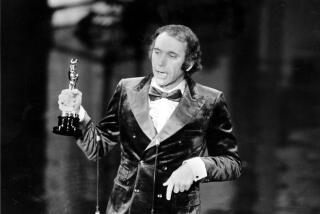John Gray pours it out with ‘White Irish Drinkers’
Reporting from Toronto — If there was a theme song for “White Irish Drinkers,” writer-director John Gray’s emotionally charged coming-of-age drama premiering Wednesday at the Toronto International Film Festival, it would probably be “You Can’t Always Get What You Want” by the Rolling Stones. But more about that later.
Over the years, many people said they liked the script and it got Gray work, yet no one wanted to make the movie. The script gathered dust for a decade until the digital age brought costs down enough for Gray to shoot the film on his own dime. The haunting memories of his tough, working-class Brooklyn childhood in the ‘70s, on which the film is based, refused to leave him alone.
While the script languished, Gray’s career was doing anything but. He wrote and directed a string of TV movies, most notably 2004’s Emmy-nominated Manson Family drama, “Helter Skelter,” which he adapted from the book by Vincent Bugliosi and Curt Gentry.
Earlier, he dipped into the world of theatrical films directing, but not writing, the 1996 Steven Seagal flick “The Glimmer Man.” But he found that projects went better when he wrote them — take the hit TV drama series “Ghost Whisperer,” which Gray created and executive produced. A few years ago, he pulled “White Irish Drinkers” out of a drawer and starting rewriting it with the idea of shooting it digitally and cheaply — scaled back, more intimate.
The semi-autobiographical story is built around the tension between 18-year-old Brian (Nick Thurston), who turns out to have a real talent for drawing, and his older brother Danny (Geoff Wigdor), who’s hard at work on the thug life. They’re both trying to survive not just the streets but also their Irish Catholic father, a mean drinker played by Stephen Lang, just off a slightly larger production in “Avatar.” Karen Allen (“Raiders of the Lost Ark”) is world-weary as their long-suffering mother, with Peter Riegert (“Crossing Delancey”) as Whitey — a mensch who runs a local movie house and has taken Brian on to help him jumpstart the business.
“I had an easier time of it than Brian, but I wanted to capture the notion of what it felt like to be different in that neighborhood — that sense of being the misfit,” said Gray, now 52. “It’s a personal story I couldn’t let go of.”
Ironically, when he rewrote it with the idea of shooting digital, his agents said they thought they could package it — meaning someone else would foot the bill. But Gray worried that might mean waiting another couple of years, and besides, he had picked November 2009 to start shooting. And he did, for 17 days. That’s all he could afford and even then, virtually everything seen in the film is borrowed — the clothes, the food, the houses.
“Eighty percent of people in this situation, it’s their first time,” Gray said of the process of shooting that first indie. “I had the great advantage of making lots of TV movies and I used that experience” — as well as his connections. Most of his crew were either friends or people he has worked with for years; they knew one another’s rhythms and talked a kind of shorthand.
With the actors, he got lucky on the veterans, who signed on for next to nothing because they liked the material. The three young leads were basically unknowns. Gray and casting director Russell Boast, also a producer on the film, found them after searching the country — Leslie Murphy (who plays Brian’s love interest) and Thurston on the West Coast, Wigdor on the East.
But back to the Stones. In one of the subplots, Whitey knows the band’s tour manager and calls in the one favor he has. He gets the Stones to agree to a surprise set at his movie house when they’re in town to play Madison Square Garden. (This was the ‘70s, when rockers did that kind of thing.) The one-night-only event would bring in enough to pay off Whitey’s debt to the local leg-breaking mobster; Danny, meanwhile, sees it as an easy mark and a ticket out of Brooklyn.
Four Stones songs had been running through Gray’s head for all the years he’d been thinking about “White Irish Drinkers.” When Gray’s team mixed the film, they used the songs in hopes they could cut a deal on the price and get what are known as festival rights. Bands, even big ones, often cut their fees for spec films — charging as low as a couple hundred bucks.
The Stones’ fee? The four songs, including “Jumpin’ Jack Flash” and “Get Off of My Cloud,” came with a price tag of $1.2 million — far more than the cost of the film. “We were devastated,” said Gray. “I thought we’d never be able to replace them.”
Enter Facebook. Gray’s wife, “Dog Whisperer” producer Melissa Jo Peltier, also a producer on the film, had posted about “White Irish.” An old college buddy, Fred Studier, got in touch and mentioned his Irish-American bar band, The Shillaly Brothers. Its raw, alt-rock sound turned out to be a perfect fit for the edgy desperation of “White Irish Drinkers” — or as Mick might say, “You can’t always get what you want, but if you try sometimes, you get what you need.”
betsy.sharkey@latimes.com
More to Read
Only good movies
Get the Indie Focus newsletter, Mark Olsen's weekly guide to the world of cinema.
You may occasionally receive promotional content from the Los Angeles Times.











